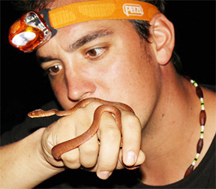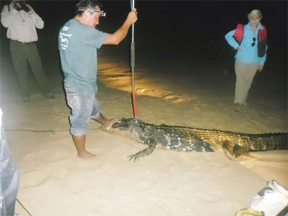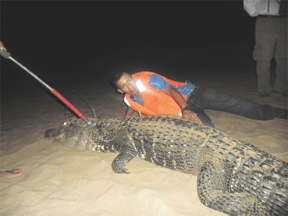Time, in Yupukari as elsewhere, waits on no Manuel.
Manuel the birdman was late and Mike the Rupunadian (which is to say he is both Rupununian and Canadian) was eager to show off the wonders of the Rupununi to some guests. “Well,” said Mike after wondering again about the whereabouts of Manuel, “time waits for no Manuel.”
And off he went.
Time in the Rupununi is different from elsewhere. Sometimes you forget what day it is and occasionally when you ask a villager, they “think” it is one day or the other. Here, in the rolling, grass-covered hills of the Rupununi, sandwiched between the Pakaraima and Kanuku mountain ranges, the day can begin at dusk or dawn depending on your interest.

You can go catch an endangered species of caiman in the evenings, feeling the thrill as an 11-foot beast struggles to overpower four experienced guides, then touch and feel the caiman if you are brave enough, or meditate silently for long minutes waiting for shy turtles to trust you and emerge from the placid water of their pond to sun themselves under a cloudless Rupununi sky.
Or you can bird-watch on the savannah or the meandering Rupununi River, go on the Awarikiru Adventure in a dugout canoe paddling past otters and other wildlife on the oxbow lake, or visit another lake where it was thought El Dorado was located. Or you can go into Yupukari village itself and listen to the fascinating stories of Macushi customs in days long past.
You can be an adventurer in Yupukari. A fisherman. An archaeologist exploring the ruins of old forts. You can stand on a hill and look to one side with the knowledge that all the water on that side flows to the Amazon and the water on the other side flows to the Essequibo; one step and you are in the Amazonian watershed, several steps back and you are in the Essequibo watershed. At this point, between these two great basins, you feel not only your place in the universe but also a wonder that you are here.

My destination: Caiman House. Set up by Americans, Alice Layton a social worker and her husband, tropical ecologist Peter Taylor who was studying black caimans in 2005. It is a guest house, a field station, and a hub for many village activities since it also houses the public library and the lone internet access point, while also being the headquarters of Rupununi Learners Incorporated and Yupukari Crafters. Built of local materials, it is powered by solar electricity and has running water and inviting, locally crafted beds with cotton headboards and pebble-top sinks.
Meeting Mike

Mike Martin is a towering Rupunadian with an accent which veers to pure Rupununian before bouncing back to Canadian then a smattering of both. An adventurer with a steady smile and a thousand stories, he came to Guyana six years ago, fell in love with the country and a stay intended to be a short one turned into years. “I love it here. Rupununi has heavy gravity. You go, you wanna come back. The lifestyle is great. Fishing and being in the bush has always been something that I did,” he later explained the ‘naa,’ ‘you know’ and ‘aarite’ of the Rupununi naturally rolling out as he spoke of the caiman project and the human-caiman conflict. “A lapsy dog? Wha? Dead!” he exclaimed pointing out that attacks on humans are extremely rare and animals are more likely to be attacked by a caiman. At Caiman House, Mike seemed to be the right hand of most things. He is officially the computer technician working for a small stipend but his range of activities encompasses almost the entire Caiman House and more than anything else, he seems to be a hardworking volunteer.
I arrived at a busy time. Caiman House was preparing to host 11 other guests – a large number for them – and things had to be done. Even so, Mike gave a quick tour of the compound explaining the caimans, the turtles, the pet cats, the purple pepper, the watershed and the research, among other things.

Wandering in the village took most of the day. Toshao Rudolph Roberts explained his plan of transforming the housing of the village from thatched roofs and mud to zinc and burnt clay bricks, a project that most villagers seemed to support with many working on the manufacturing of the bricks. At the village’s lone bar on the outskirts of the community, Neymar the monkey formerly known as Sheiko before a hairstyle change to the ‘pica-pau’ style made famous by the Brazilian footballer Neymar precipitated the name change, greeted visitors. Pica-pau is Portuguese for woodpecker.
At dusk, it was time to seek the Melanosuchus niger – the Amazon’s largest predator.

Melanosuchus niger, the black caiman
